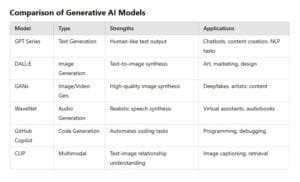Generative AI models are the backbone of AI systems capable of creating text, images, music, and other forms of media. These models utilize advanced machine learning architectures, often requiring significant computational power and vast datasets. Below is an overview of some of the most popular and influential generative AI models, categorized by their primary applications and underlying technologies.
1. Text Generation Models
Generative AI has seen remarkable advancements in Natural Language Processing (NLP), where models can generate coherent and contextually relevant text.
GPT Series (Generative Pre-trained Transformer)
- Developer: OpenAI.
- Technology: Based on transformer architecture, GPT models are pre-trained on large text datasets and fine-tuned for specific tasks.
- Applications:
- Chatbots and conversational AI (e.g., ChatGPT).
- Content creation, summarization, and translation.
- Notable Versions:
- GPT-3: Known for its capability to generate human-like text.
- GPT-4: Improved accuracy and multimodal capabilities (understands text and images).
BERT (Bidirectional Encoder Representations from Transformers)
- Developer: Google AI.
- Purpose: Focused on understanding context in both directions of text (bidirectional).
- Applications: Text classification, sentiment analysis, and question answering.
- Difference from GPT: While GPT excels in text generation, BERT is primarily designed for understanding and processing text.
T5 (Text-to-Text Transfer Transformer)
- Developer: Google Research.
- Key Feature: Treats all NLP tasks as text-to-text problems.
- Applications: Translation, summarization, and question answering.
2. Image and Video Generation Models
Generative AI has made significant strides in visual media creation, with models producing high-quality images and videos from minimal inputs.
DALL·E Series
- Developer: OpenAI.
- Technology: Transformer-based model designed for image generation from text prompts.
- Key Capabilities:
- Creating highly detailed, realistic, or imaginative images.
- Editing images through prompts (inpainting).
- Applications: Graphic design, marketing, and concept art.
Stable Diffusion
- Developer: Stability AI.
- Technology: Uses diffusion models to generate images by reversing a noise-adding process.
- Strengths:
- Open-source availability, encouraging widespread use and experimentation.
- Efficient resource usage compared to earlier models.
- Applications: Art generation, media production, and creative industries.
GANs (Generative Adversarial Networks)
- Developer: Concept introduced by Ian Goodfellow (2014).
- Technology: Consists of two networks, the generator and the discriminator, in a feedback loop:
- Generator: Creates synthetic data.
- Discriminator: Evaluates data authenticity.
- Applications:
- Creating deepfakes.
- Super-resolution imaging (enhancing image quality).
- Artistic style transfer.
3. Multimodal Models
These models integrate multiple data types, such as combining text and images or audio and video.
CLIP (Contrastive Language–Image Pre-training)
- Developer: OpenAI.
- Purpose: Understands relationships between text and images.
- Applications:
- Image captioning and retrieval.
- Assisting text-to-image generators like DALL·E.
Imagen
- Developer: Google Research.
- Technology: Uses a text-to-image framework that combines advanced language understanding with image synthesis.
- Key Strength: Produces highly photorealistic and detailed images.
- Applications: Art creation, product visualization.
DeepMind’s Gato
- Developer: DeepMind.
- Technology: A generalist AI model capable of performing multiple tasks across different domains.
- Key Feature: Handles text, image, and control-based tasks in a single framework.
4. Audio and Music Generation Models
Generative AI models for audio can synthesize music, replicate human speech, or create soundscapes.
Jukebox
- Developer: OpenAI.
- Technology: Neural network trained to generate music with lyrics.
- Applications:
- Music composition in various genres.
- Creating background scores for multimedia.
WaveNet
- Developer: DeepMind.
- Purpose: Generates high-quality, human-like speech.
- Applications:
- Text-to-speech systems in virtual assistants.
- Audiobook narration.
5. Code Generation Models
Generative AI models have become essential tools for software development, automating parts of the coding process.
GitHub Copilot
- Developer: GitHub (powered by OpenAI Codex).
- Technology: Trained on billions of lines of code to assist developers.
- Applications:
- Code completion.
- Suggesting solutions to programming problems.
- Writing boilerplate code.
Codex
- Developer: OpenAI.
- Purpose: A specialized GPT model for programming languages.
- Applications:
- Generating code snippets.
- Translating code between languages.
6. Emerging Generative AI Models
- Make-A-Video: Meta’s AI tool for generating short video clips from text prompts.
- Google’s MusicLM: Generates music from textual descriptions, including specific styles and instruments.
- DiffEdit: A model that modifies images based on textual edits.

